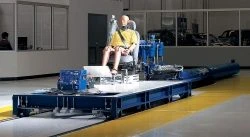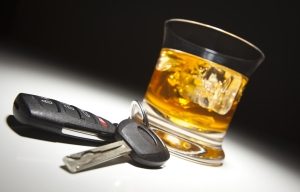
During the Insurance Institute for High Safety’s automobile safety testing, the Vehicle Research Center is home to a variety of types of crash tests. Not all of these tests require entire vehicles behind crashed, though.
Automobile crashes can be simulated in the sled lab. This lab makes use of a sled running on fixed rails that allows for testing of head restraints or gear within a vehicle, such as booster seats. The IIHS workers attach components to the sled and crash dummies are often used in those components. The sled is a steel flatbed that runs on rails that can be programmed to do specific accelerations and decelerations. The sled mimics an actual vehicle so that the dummy shows what would happen to an actual occupant in a real-world wreck. These sled lab tests are much easier and less expensive to set up than full-scale automobile tests.
One of the regular evaluations of vehicles performed at the Vehicle Research Center is an evaluation of whether or not the vehicle’s seats are able to provide protection against whiplash injuries. This evaluation is based on simulating a rear crash. The vehicle seats are taken out of the vehicle and mounted to the sled, which is then moved as if it were a car that had been struck in a rear crash. The test simulates the kind of crash that might consist of a vehicle being struck from behind by a vehicle weighing about the same at 20 MPH. The measurements from the dummy are then used to judge which seats are doing a better job of moving the head together with the rest of the body in a way that reduces the stresses and strains in the neck. Booster seat evaluations are often performed using the sled as well.
Another test performed at the VRC that doesn’t include a full vehicle crash is for rollovers. It is very important to have a strong roof in a rollover rash because it keeps the survival space, or occupant compartment, intact. The vehicle should absorb the forces and energy of the crash without deforming the occupant space so that there’s room inside for the restraints work properly. Roof strength is also important because of the risks associated with ejection during a rollover. If the car’s roof stays in place, then the windshield and side windows are more likely to stay in place as well, therefore keeping occupants inside the vehicle. The IIHS uses a roof crush machine, which measures the strength of the roof of the vehicle. This machine uses hydraulic cylinders to push a steel plate into one corner of the roof at a constant speed. The maximum force that it takes to crush the car is recorded and then divided by the vehicle’s weight to come up with the strength-to-weight ratio. In the IIHS system of ratings, a vehicle must be able to achieve a ratio of four or greater in order to receive a “good”. This test has made a huge difference in the roof strength of vehicles on the road.
These types of tests performed at the IIHS’s Vehicle Research Center, as well as vehicle crash tests, work towards making motor vehicles safer for everyone on the road.
Categories: Auto Accidents, Car Accident, Personal Injury




